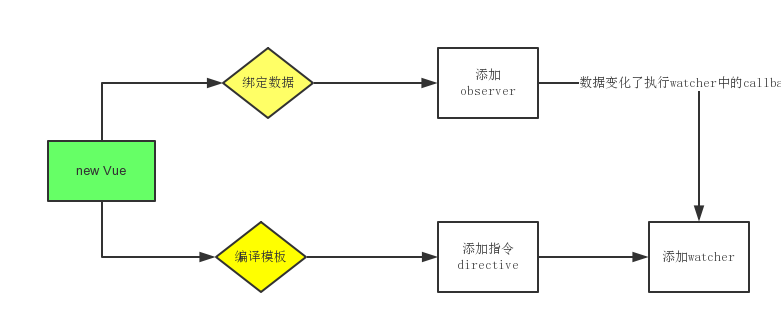vue数据绑定原理
一、定义
vue的数据双向绑定是基于Object.defineProperty方法,通过定义data属性的get和set函数来监听数据对象的变化,一旦变化,vue利用发布订阅模式,通知订阅者执行回调函数,更新dom。
二、实现
vue关于数据绑定的生命周期是: 利用options的data属性初始化vue实力data---》递归的为data中的属性值添加observer--》编译html模板--》为每一个{{***}}添加一个watcher;
var app = new Vue({
data:{
message: 'hello world',
age: 1,
name: {
firstname: 'mike',
lastname: 'tom'
}
}
});
1.初始化data属性
this.$data = options.data || {};
这个步骤比较简单将data属性挂在到vue实例上即可。
2.递归的为data中的属性值添加observer,并且添加对应的回调函数(initbinding)
function Observer(value, type) {
this.value = value;
this.id = ++uid;
Object.defineProperty(value, '$observer', {
value: this,
enumerable: false,
writable: true,
configurable: true
});
this.walk(value); // dfs为每个属性添加ob
}
Observer.prototype.walk = function (obj) {
let val;
for (let key in obj) {
if (!obj.hasOwnProperty(key)) return;
val = obj[key];
// 递归this.convert(key, val);
}
};
Observer.prototype.convert = function (key, val) {
let ob = this;
Object.defineProperty(this.value, key, {
enumerable: true,
configurable: true,
get: function () {
if (Observer.emitGet) {
ob.notify('get', key);
}
return val;
},
set: function (newVal) {
if (newVal === val) return;
val = newVal;
ob.notify('set', key, newVal);//这里是关键
}
});
};
上面代码中,set函数中的notify是关键,当用户代码修改了data中的某一个属性值比如app.$data.age = 2;,那么ob.notify就会通知observer来执行上面对应的回掉函数。
绑定回掉函数
exports._updateBindingAt = function (event, path) {
let pathAry = path.split('.');
let r = this._rootBinding;
for (let i = 0, l = pathAry.length; i < l; i++) {
let key = pathAry[i];
r = r[key];
if (!r) return;
}
let subs = r._subs;
subs.forEach((watcher) => {
watcher.cb(); // 这里执行watcher的回掉函数
});
};
/**
* 执行本实例所有子实例发生了数据变动的watcher
* @private
*/
exports._updateChildrenBindingAt = function () {
if (!this.$children.length) return;
this.$children.forEach((child) => {
if (child.$options.isComponent) return;
child._updateBindingAt(...arguments);
});
};
/**
* 就是在这里定于数据对象的变化的
* @private
*/
exports._initBindings = function () {
this._rootBinding = new Binding();
this.observer.on('set', this._updateBindingAt.bind(this))
};
有2点需要注意:1),如果data中message:'hello world' => message: {id: 1, str: 'hello world'},message.id不会添加observer,所以一般为$data增加属性时,可以使用全局VM.set(target, key, value)方法。
2),如果是data属性值是一个数组,那么数组变化就不能检测到了,这时候可以从写这个数组对象的原生方法,在里面监听数据的变化就可以。具体做法是重写数组对象的__proto__。
const aryMethods = ['push', 'pop', 'shift', 'unshift', 'splice', 'sort', 'reverse'];
const arrayAugmentations = []; aryMethods.forEach((method)=> { // 这里是原生Array的原型方法
let original = Array.prototype[method]; arrayAugmentations[method] = function () {
console.log('我被改变啦!');// 这里添加wather return original.apply(this, arguments);
}; }); let list = ['a', 'b', 'c']; list.__proto__ = arrayAugmentations;
list.push('d');
3.编译模板
这个是数据绑定的关键步骤,具体可以分为一下2个步骤。
A)解析htmlElement节点,这里要dfs所有的dom和上面对应的指令(v-if,v-modal)之类的
B)解析文本节点,把文本节点中的{{***}}解析出来,通过创建textNode的方法来解析为真正的HTML文件
在解析的过程中,会对指令和模板添加Directive对象和Watcher对象,当data对象的属性值发生变化的时候,调用watcher的update方法,update方法中保存的是Directive对象更新dom方法,把在当directive对应的textNode的nodeValue变成新的data中的值。比如执行app.$data.age = 1;
首先编译模板
exports._compile = function () {
this._compileNode(this.$el);
};
/**
* 渲染节点
* @param node {Element}
* @private
*/
exports._compileElement = function (node) {
if (node.hasChildNodes()) {
Array.from(node.childNodes).forEach(this._compileNode, this);
}
};
/**
* 渲染文本节点
* @param node {Element}
* @private
*/
exports._compileTextNode = function (node) {
let tokens = textParser.parse(node.nodeValue); // [{value:'姓名'}, {value: 'name‘,tag: true}]
if (!tokens) return;
tokens.forEach((token) => {
if (token.tag) {
// 指令节点
let value = token.value;
let el = document.createTextNode('');
_.before(el, node);
this._bindDirective('text', value, el);
} else {
// 普通文本节点
let el = document.createTextNode(token.value);
_.before(el, node);
}
});
_.remove(node);
};
exports._compileNode = function (node) {
switch (node.nodeType) {
// text
case 1:
this._compileElement(node);
break;
// node
case 3 :
this._compileTextNode(node);
break;
default:
return;
}
};
上面代码中在编译textNode的时候会执行bindDirctive方法,该方法的作用就是绑定指令,{{***}}其实也是一条指令,只不过是一个特殊的text指令,他会在本ob对象的directives属性上push一个Directive对象。Directive对象本身在构造的时候,在构造函数中会实例化Watcher对象,并且执行directive的update方法(该方法就是把当前directive对应的dom更新),那么编译完成后就是对应的html文件了。
/**
* 生成指令
* @param name {string} 'text' 代表是文本节点
* @param value {string} 例如: user.name 是表示式
* @param node {Element} 指令对应的el
* @private
*/
exports._bindDirective = function (name, value, node) {
let descriptors = dirParser.parse(value);
let dirs = this._directives;
descriptors.forEach((descriptor) => {
dirs.push(
new Directive(name, node, this, descriptor)
);
});
};
function Directive(name, el, vm, descriptor) {
this.name = name;
this.el = el; // 对应的dom节点
this.vm = vm;
this.expression = descriptor.expression;
this.arg = descriptor.arg;this._bind();
}
/**
* @private
*/
Directive.prototype._bind = function () {
if (!this.expression) return;
this.bind && this.bind();
// 非组件指令走这边
this._watcher = new Watcher(
// 这里上下文非常关键
// 如果是普通的非组件指令, 上下文是vm本身
// 但是如果是prop指令, 那么上下文应该是该组件的父实例
(this.name === 'prop' ? this.vm.$parent : this.vm),
this.expression,
this._update, // 回调函数,目前是唯一的,就是更新DOM
this // 上下文
);
this.update(this._watcher.value);
};
exports.bind = function () {
};
/**
* 这个就是textNode对应的更新函数啦
*/
exports.update = function (value) {
this.el['nodeValue'] = value;
console.log("更新了", value);
};
但是,用户代码修改了data怎么办,下面是watcher的相关代码,watcher来帮你解决这个问题。
/**
* Watcher构造函数
* 有什么用呢这个东西?两个用途
* 1. 当指令对应的数据发生改变的时候, 执行更新DOM的update函数
* 2. 当$watch API对应的数据发生改变的时候, 执行你自己定义的回调函数
* @param vm
* @param expression {String} 表达式, 例如: "user.name"
* @param cb {Function} 当对应的数据更新的时候执行的回调函数
* @param ctx {Object} 回调函数执行上下文
* @constructor
*/
function Watcher(vm, expression, cb, ctx) {
this.id = ++uid;
this.vm = vm;
this.expression = expression;
this.cb = cb;
this.ctx = ctx || vm;
this.deps = Object.create(null);//deps是指那些嵌套的对象属性,比如name.frist 那么该watcher实例的deps就有2个属性name和name.first属性
this.initDeps(expression);
}
/**
* @param path {String} 指令表达式对应的路径, 例如: "user.name"
*/
Watcher.prototype.initDeps = function (path) {
this.addDep(path);
this.value = this.get();
}; /**
根据给出的路径, 去获取Binding对象。
* 如果该Binding对象不存在,则创建它。
* 然后把当前的watcher对象添加到binding对象上,binding对象的结构和data对象是一致的,根节点但是rootBinding,所以根据path可以找到对应的binding对象
* @param path {string} 指令表达式对应的路径, 例如"user.name"
*/
Watcher.prototype.addDep = function (path) {
let vm = this.vm;
let deps = this.deps;
if (deps[path]) return;
deps[path] = true;
let binding = vm._getBindingAt(path) || vm._createBindingAt(path);
binding._addSub(this);
};
初始化所有的绑定关系之后,就是wather的update了
/**
* 当数据发生更新的时候, 就是触发notify
* 然后冒泡到顶层的时候, 就是触发updateBindingAt
* 对应的binding包含的watcher的update方法就会被触发。
* 就是执行watcher的cb回调。watch在
* 两种情况, 如果是$watch调用的话,那么是你自己定义的回调函数,开始的时候initBinding已经添加了回调函数
* 如果是directive,那么就是directive的_update方法
* 其实就是各自对应的更新方法。比如对应文本节点来说, 就是更新nodeValue的值
*/
三、结论

vue数据绑定原理的更多相关文章
- 17: VUE数据绑定 与 Object.defineProperty
VUE数据绑定原理:https://segmentfault.com/a/1190000006599500?utm_source=tag-newest Object.defineProperty(): ...
- vue双向数据绑定原理探究(附demo)
昨天被导师叫去研究了一下vue的双向数据绑定原理...本来以为原理的东西都非常高深,没想到vue的双向绑定真的很好理解啊...自己动手写了一个. 传送门 双向绑定的思想 双向数据绑定的思想就是数据层与 ...
- Vue数据绑定和响应式原理
Vue数据绑定和响应式原理 当实例化一个Vue构造函数,会执行 Vue 的 init 方法,在 init 方法中主要执行三部分内容,一是初始化环境变量,而是处理 Vue 组件数据,三是解析挂载组件.以 ...
- 「每日一题」有人上次在dy面试,面试官问我:vue数据绑定的实现原理。你说我该如何回答?
关注「松宝写代码」,精选好文,每日一题 时间永远是自己的 每分每秒也都是为自己的将来铺垫和增值 作者:saucxs | songEagle 来源:原创 一.前言 文章首发在「松宝写代码」 2020. ...
- 手写MVVM框架 之vue双向数据绑定原理剖析
<!DOCTYPE html> <html> <head> <meta charset="UTF-8"> <title> ...
- vue 实现数据绑定原理
案例: Vue 底层原理 // 目的: 使用原生js来实现Vue深入响应式 var box = document.querySelector('.box') var button = ...
- 浅析vue数据绑定
前言:最近团队需要做一个分享,脚进脑子,不知如何分享.最后想着之前一直想研究一下 vue 源码,今天刚好 "借此机会" 研究一下. 网上研究vue数据绑定的文章已经非常多了,但是自 ...
- Vue工作原理小结
本文能帮你做什么?1.了解vue的双向数据绑定原理以及核心代码模块2.缓解好奇心的同时了解如何实现双向绑定为了便于说明原理与实现,本文相关代码主要摘自vue源码, 并进行了简化改造,相对较简陋,并未考 ...
- vue运行原理
Vue工作原理小结 本文能帮你做什么? 1.了解vue的双向数据绑定原理以及核心代码模块 2.缓解好奇心的同时了解如何实现双向绑定 为了便于说明原理与实现,本文相关代码主要摘自vue源码, 并进行了简 ...
随机推荐
- 安迪的第一个字典(Andy's First Dictionary,UVa 10815)
Description Andy, , has a dream - he wants to produce his very own dictionary. This is not an easy t ...
- [转]tomcat部署(1)
阅读目录 1 目录结构 2 部署 3 发布 4 测试 本篇参考Tomcat官方文档:<First Webapp>翻译,并结合自己的开发经验介绍关于tomcat部署以及发布的相关内容. ...
- Page directive must not have multiple occurrences of pageencoding
一个jsp文件中不能同时出现两个 p.p1 { margin: 0.0px 0.0px 0.0px 0.0px; font: 11.0px Monaco; color: #932192 } pageE ...
- hibernate操作步骤(代码部分)
1.加载hibernate的核心配置文件 2.创建SessionFactory对象 3.使用SessionFactory创建Session对象 4.开启事务(手动开启) 5.写具体逻辑crud,增删改 ...
- php调用java
PHP调用JAVA方式 1. 背景 在开发招商银行信用卡分期付款功能过程中,在支付成功之后需要对银行的返回数据进行签名验证,因签名加密方式招商银行是不提供的,只提供了相应的JAVA验证类测试例 ...
- ztree学习笔记(一)
在项目当中,经常会用到ztree树形插件,之前做的几个项目当中都用到了这个插件,感觉功能还是很强大的,而且在网上还找到了中文的API,因为项目中的树形结构不是自己做的,所以现在从头学习一下,并且记录一 ...
- JavaScript对象之document对象
DOM对象之document对象 DOM对象:当网页被加载时,浏览器会创建页面的文档对象模型(Document Object Model). HTML DOM 模型被构造为对象的树. 打开网页后,首先 ...
- 流畅的python学习笔记:第三章
字典的变种: OrderedDict 首先来看下面的代码,在一个字典中,有name,age,city,在遍历这个字典的时候.顺序却是随机的,不是按照我们添加的顺序也就是name->age-> ...
- web移动端布局方式整理
写H5页面一直写的有点随意,只是保证了页面在各个屏幕下显示良好,却没有保证到在各个屏幕下是等比例放大或者缩小.这些天在写一些页面,试着看看能不能写出等比例放大缩小的页面,发现不容易啊,在网上找了一些文 ...
- PHP提取字符串中的所有汉字
<?php $str = 'aiezu.com 爱E族, baidu.com 百度'; preg_match_all("#[\x{4e00}-\x{9fa5}]#u", $s ...
